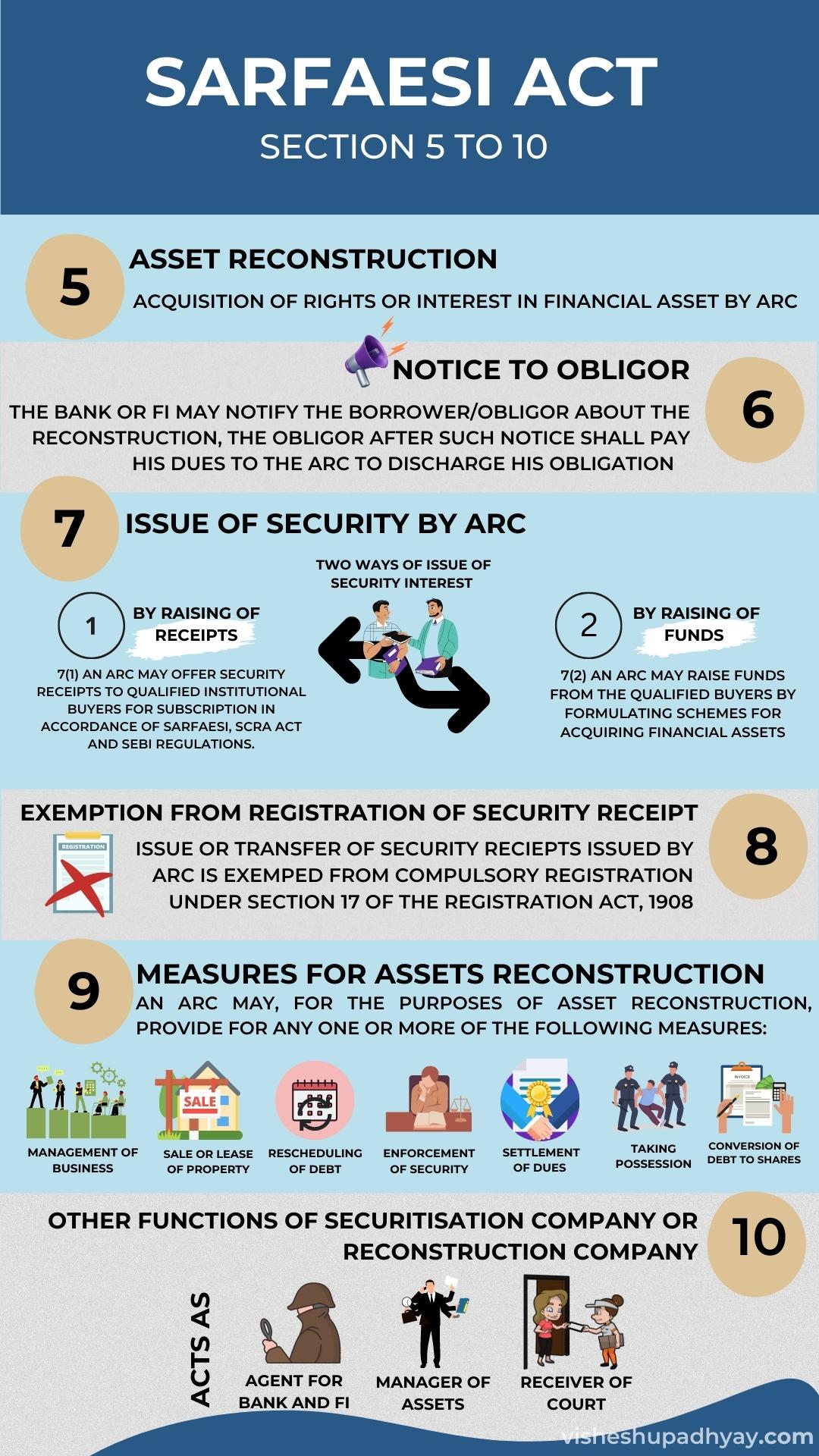SARFAESI ACT 2002
The SARFAESI Act, was enacted on December 2002, "Securitisation and Reconstruction of Financial Assets and Enforcement of Security Interest" (Sarfaesi) Act was enacted with an intend to empower the Banks and Financial Institutions(FIs) to recover non performing Assets without the intervention of a court.
The Securitisation and Reconstruction of Financial Assets and Enforcement of Security Interest (SARFAESI) Act, 2002 is a powerful tool used by financial institutions to recover their non-performing assets (NPAs) quickly and efficiently.
This act empowers banks and financial institutions to seize and sell the assets of a borrower who has defaulted on their loan payments, without requiring the intervention of the court.
The SARFAESI Act, 2002, is divided into SIX chapters. The six chapters are as follows:
Chapter I Section : 1 and 2
Preliminary - This chapter provides the short title, extent, and commencement
of the Act, along with definitions of the various terms used in the Act.
Chapter II Section : 3-12B
Securitisation and Reconstruction of Financial Assets - This chapter deals with
the securitization and reconstruction of financial assets by asset reconstruction companies (ARCs).
Chapter 3 Section : 13-19
Enforcement of Security Interest - This chapter deals with
the enforcement of security interest by banks and financial institutions and the procedure for taking possession of and selling the secured assets.
Chapter IV Section : 20-26A
Central Registry -
This chapter deals with the Formulation of CERSAI
Chapter IVA Section : 26B - 26A
Registration by secured creditors and other creditors
Chapter V Section : 27-30D
Offences and Penalties
Chapter VI Section : 31-42
MISCELLANEOUS
Section 2 of the SARFAESI Act defines various important terms used in the act such as "banking company," "borrower," "default," "financial asset," "secured creditor," and "security interest." These terms are important
as they form the foundation of the SARFAESI Act and help in understanding the provisions of the act.
Asset Reconstruction Company is a Company Registerd with RBI under Section 3 of Sarfaesi act. ARC acts as an Agent for any bank or Financial Institution for
the purpose of Recovery of their dues from Borrowes on Payment of fees or charges.
Section 3 Registration of ARC : Minimum net owned fund 2 crore, Obtain a Certificate of registration under section 3, "If RBI is satisfied that the Company Follows all the conditions under 3 (2)" RBI may inspect
books or records for considering the application.
Section 4 Cancellation of Registration, RBI on Grounds Specified under Section 4 may cancel the Certificate of ARC after providing sufficient opportunity of being heard.
If such Company :
(a) ceases to carry on the business of Securitisation or Asset Reconstruction; or
(b) ceases to receive or hold any investment from a Qualified buyer; or
(c) has failed to comply
with any conditions subject to which the certificate of registration has been granted to it; or
(d) at any time fails to fulfil any of the conditions referred to in clauses (a) to (g) of
sub-section (3) of section 3; or
(e) fails to--
(i) comply with any direction issued by the Reserve Bank under the provisions of this Act; or
(ii) maintain accounts in accordance with the requirements
of any law or any direction or order issued by the Reserve Bank under the provisions of this Act; or
(iii) submit or offer for inspection its books of account or other relevant documents when so demanded by the Reserve Bank;
or
(iv) obtain prior approval of the Reserve Bank required under sub-section (6) of section 3:
Section 5 Asset Reconstruction - Acquisition of rights or interest in financial asset by ARC
Section 6 Notice to Obligor - The Bank or FI may notify the borrower/obligor about the reconstruction, the obligor after such notice shall pay his dues to the arc to discharge his obligation.
Section 7 Issue of Security by Asset Reconstruction Company
Two ways of issue of security interest
1. By raising of Receipts Section7(1) An ARC may offer security receipts to qualified institutional buyers for subscription in accordance of sarfaesi, scra act and sebi regulations.
2. By raising of funds Section 7(2) An ARC may raise funds from the qualified buyers by formulating schemes for acquiring financial assets.
Section 8 Exemption from registration of security receipt, Issue or transfer of security reciepts issued by arc is exemped from compulsory registration under section 17 of the Registration Act, 1908.
Section 9 Measures for assets reconstruction by ARC
An ARC may, for the purposes of asset reconstruction, provide for any one or more of the following measures:
(a) the proper management of the business of the borrower, by change in, or take over of, the management of the business of the borrower;
(b) the sale or lease of a part or whole of the business of the borrower;
(c) rescheduling
of payment of debts payable by the borrower;
(d) enforcement of security interest in accordance with the provisions of this Act;
(e) settlement of dues payable by the borrower;
(f) taking possession of secured
assets in accordance with the provisions of this Act;
(g) conversion of any portion of debt into shares of a borrower company:
Section 10 Other functions of ARC
(a) act as an agent for any bank or financial institution for the purpose of recovering their dues from the borrower on payment of such fees or charges as may be mutually
agreed upon between the parties;
(b) act as a manager referred to in clause (c) of sub-section (4) of section 13 on such fee as may be mutually agreed upon between the parties;
(c)
act as receiver if appointed by any court or tribunal:
Section 11 Resolution of disputes
Where any dispute relating to securitisation or reconstruction or nonpayment of any amount due including interest arises amongst any of the parties, namely, the
bank, or financial institution, or ARC or Qualified buyer, such dispute shall be settled settled by conciliation or arbitration as provided in the Arbitration and Conciliation Act,
Section 12 Power of Reserve Bank to determine policy and issue directions.
Section 13 of the SARFAESI Act empowers the secured creditor (bank or financial institution) to give a notice in writing to the borrower to discharge their liability within 60 days from the date of the notice.
If
the borrower fails to discharge their liability within the stipulated time, the secured creditor may take recourse to any one or more of the following measures:
1. Take possession of the secured asset
2. Sale or lease or assign the right to use the secured asset
3. Manage the secured asset
4. Appoint any person to manage the secured asset
SARFAESI Rules provides
for the procedure for the sale of the secured asset. The secured creditor has to issue a notice in writing to the borrower and co-borrower (if any) and publish a notice in two newspapers (one in vernacular language) for
the sale of the secured asset.
Further, SARFAESI Law provides for the rights of the purchaser of the secured asset. The purchaser of the secured asset gets the right, title, and interest
in the secured asset free from all encumbrances.
Section 14 Assitance of District megistrate or Chief Metropolitan Magistrate, the Secured creditor may take assitance of DM or CMM for
enforcement of security interest under section 13, by written application with attached affidavit and documents
Section 15 of the SARFAESI Act provides for the power of the
secured creditor to take over the management of the business of the borrower. The secured creditor can appoint any person to manage the business of the borrower in case of default.
Section 16 No
compensation to directors for loss of office in case of takeover of Management under section 15.
Section 17 of the SARFAESI Act provides for the right of the borrower to make representation
to the secured creditor against the measures taken by them under section 13(4) and section 14 of the Act.
Section 18 of the SARFAESI Act provides for the establishment of Debt Recovery
Tribunals (DRTs) and their jurisdiction. The DRTs are quasi-judicial bodies that have the power to adjudicate on matters related to the recovery of debts due to banks and financial institutions.
Section 19 of
the SARFAESI Act provides for the establishment of Debt Recovery Appellate Tribunals (DRATs) and their jurisdiction. The DRATs are appellate bodies that hear appeals against the orders of the DRTs.
Section 27 of
the SARFAESI Act provides for the penalties for non-compliance with the provisions of the act. Any person who fails to comply with the provisions of the act shall be punishable with imprisonment for a term which may extend
to one year, or with a fine, or with both.
Section 31 Exemptions of section 13
Provisions and procedure of section 13 are not applicable on :
Lien on goods under contract
act, Pledge of movables under contract act, Creation of security interest in aircraft, Creation of security interest in vessel, Any rights of unpaid seller under Sells of Goods act, Properties not liable under Civil Procedure
code, Agriculture land, If Amount due is less than 20 percent, and If Security interest is less than ₹1 lakhs.
Section 34 Civil Courts have no jurisdiction to try the suits or pleading related
to Sarfaesi or DRT.
Section 35 Overriding effect over other acts Except: (section 37)
Section 37 : Companies act, SEBI, SCRA, RBDFI and IBC( NCLAT on Innoventive vs. ICICI
Bank:Supreme Court case law)
Section 38 of the SARFAESI Act provides for the power of the Central Government to make rules for carrying out the provisions of the act.
Why you should Know about the ACT?
The SARFAESI Act, 2002, is an important law for borrowers, banks, and financial institutions in India. As a borrower, it is essential to be aware of the provisions of the Act to understand your rights and liabilities in case
of default. On the other hand, banks and financial institutions need to know the provisions of the Act to recover their dues effectively.
SARFAESI is one of the most Common Law and useful in day to day Life, every one
should know about the SARFAESI Law.
This Article might be Useful for :
→ Bank Employees
→ Law Student
→ Professionals
→ Business Person
→ Have an Existing or Applying for a new Mortgage Loan
→ Mortgage Loans i.e. Home, Car Loan, etc
Conclusion
The Provisions of SARFAESI Act does not apply to unsecured loans (i.e Personal Loans, Credit Crads etc), loans below ₹100,000 or where remaining debt is below 20% of the original principal.
SARFAESI Act allowed the creation of asset reconstruction companies (ARC) and allowed banks to sell their non-performing assets to ARC's. Banks and FIs are allowed to take possession of the collateral property
and sell it without the permission of a court.
In conclusion, the SARFAESI Act is an important tool for banks and financial institutions to recover their non-performing assets efficiently. The act provides for various measures such as the seizure and sale of assets, management
of the borrower's business, and the establishment of DRTs and DRATs for the adjudication of disputes related to debt recovery. The act also imposes penalties for non-compliance and provides for the power of the Central
Government to make rules for the effective implementation of the act. The SARFAESI Act has significantly improved the process of debt recovery in India and has helped banks and financial institutions to recover their
dues in a timely and efficient manner.





